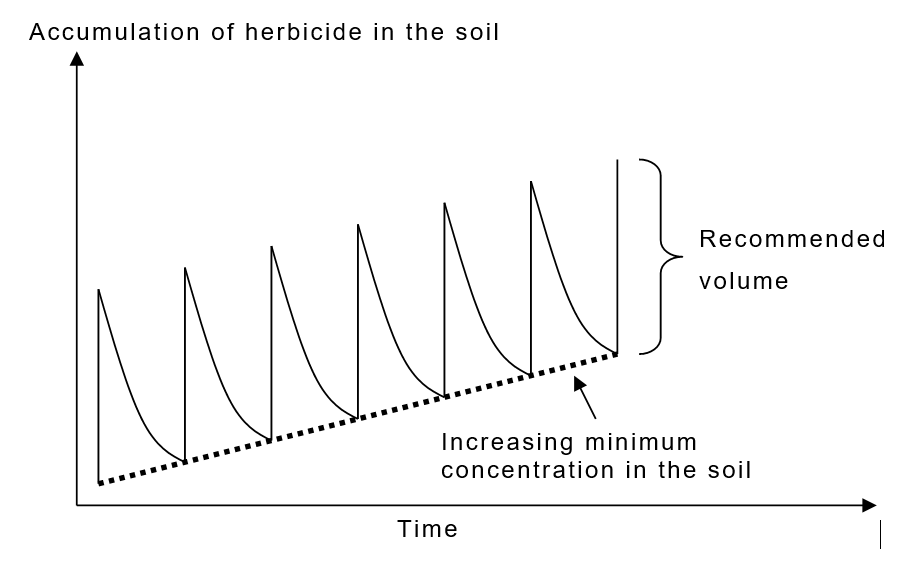The selection of herbicides is not always based on the weed that it should control. There are many conditions in the environment that will influence the grower or user’s decision to use a specific herbicide. For instance, the length that the herbicide will be active in the soil will be of major importance with vegetable crops which are planted in quick succession in the same piece of land.
Classification according to time of application
There are four periods when herbicides can be applied. These are:
- Before planting
- After planting but pre-emergence
- Post emergence
- Pre-emergence
Classification according to place of application
There are three areas where a herbicide can be applied:
- On leaves of the weeds
- Directly on top of the soil
- Incorporated into the soil
Classification according to weed specie controlled
There are two basic types of herbicides:
- Narrow spectrum: controls only a selected few weed species
- Wide spectrum: Controls a wide spectrum of weed species. If not careful it will damage both weed and commercial crop.
In order to widen the selectivity of herbicides, many growers combine one or two products. However it is not advisable to mix any two given chemicals due to the chemical action that might take place. Consult a specialist if “cocktails” are required.
Classification according to toxicity towards other animals
The toxicity towards animals is designated by the sign LD50. Most herbicides have a relative high LD50 value. The LD50 value provides the user and indication of the toxicity towards any animal, even humans. If a chemical has a LD50 value of1,000 it means that if the animal weighs 100kg, it will have a 50% chance of living (or dying) if it absorbs 100g of the chemical.
Classification according to safety margins
The accuracy with which herbicides must be measured and the phytotoxic effect which will result from any deviation from the recommended amount, differs. Phytotoxic damage is more likely to happen with herbicides that have to mixed in small dosages such as 1 ml/100 L – 10 ml/100 L of water than with those with higher volumes such as 100 ml/100 L – 1000 mL/100 L of water. The percentage mistake can be seen in Table 4. This can have a significant effect on the final result as well as the cost of controlling the weed chemically. The phytotoxic sensitivity of herbicides is shown in Figure 8.
An example of the sensitivity of making a 2 ml mistake with varying required amounts of herbicides| Recommended | Added | % mistake |
|---|---|---|
| 1 ml/100 L | 2 ml/100 L | 2 |
| 10 ml/100 L | 12 ml/100 L | 0.2 |
| 100 ml/100 L | 102 ml/ 100 L | 0.02 |

Graphical example of the sensitivity of two herbicides when increasing the volume mixed above the recommended rate.
Classification according to length of soil activity
The length of time that herbicides stay active in the soil varies considerable. Some herbicides break down immediately such as paraquat (Gramoxone) if they come in contact with soils, whereas others such as ethoxysulfuron has a waiting period for most crops between 12 months and 24 months. This limits the scope of follow-up crops a grower may plant without the herbicide having a negative affect on it.
The residual effect of herbicide application must also be taken into consideration especially when the same herbicide is applied year after year (Figure below).

By using a herbicide with residual action in the soil the concentration of the herbicide may increase if the following applications are to close to each other or if the dosages are to high. Climate may also play a role in lengthening the residual effect in the soil
Classification according to chemical structure
Classifying herbicides according to chemical structure is of academic importance and the average grower will not use this type of classification. The chemical component that is used to classify the herbicides are usually aromatic rings and other types of chemical formulations.
Classification according to physical appearance
Herbicides can be grouped into three physical categories:
- Liquids: as suspension when solids are mixed in liquids or emulsions when liquids are mixed in liquids.
- Gasses: Examples are Carbon bisulphide and Methyl Bromide. Methyl Bromide contains a type of teargas in order to warn users of its presence.
- Solid phase: These herbicides are powders, granules and pellets.
Classification according to degree of trans location
Two types are found: - Systemic: These herbicides are trans located through the plant by the various pathways.
- Contact: These herbicides destroys the area of the plant on which it made contact.
Most herbicides have properties which fall either more to one side or the other or 50:50 properties. It is seldom that a herbicide would have 60:40 relation between systemic and contact properties. The most common is 100:0, 80:20, 50:50, 20:80 and 0:100 ration between systemic and contact properties.




Leave A Comment
You must be logged in to post a comment.